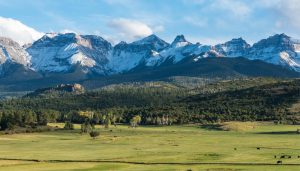The southern parts of the Rocky Mountains enjoy a warmer and drier climate and the vegetation reflects this. Taxonomic variants are noticeable for species that are common in both the Coastal Mountains and the Rocky Mountains. For example, Coast Douglas fir (Green Douglas) is more prevalent on the Coastal Mountains whereas the Rocky Mountain Douglas (Blue Douglas) is more at home in the Eastern Rockies. The Shore Lodgepole pine prefers the coastal zone, whereas the Sierra Lodgepole pine tends to predominate in the Sierra Nevada and the Broadleaf Lodgepole pine in the Rocky Mountains. In the spruce zone we find Engelmann spruce and Colorado spruce, the latter with even stiffer and sharper needles than the first. Colorado spruce is also called Blue spruce because of the common blue shine in the crown – the feature is encouraged in many cultivars for ornamental purposes. It is not to be confused with the Colorado silver fir, a species also found in this arboretum group. A few young Rocky Mountains junipers stand on the spot where there used to be Colorado Bristlecone pine, an alpine dwarf tree known to grow very old, but not in Tervuren, because it barely survived here for 25 years.


